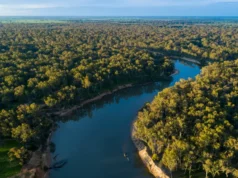Photo credit: Ricky French
There’s a photo 16-year-old Ivy McGufficke likes to look at every time she returns for the holidays to her family farm near Cooma after a term at boarding school in Mittagong. It’s 2005 and two-year-old Ivy is standing in a sheep pen wearing a red jacket, holding a half-eaten sandwich in one hand and in the other hand an old tub of Permatrace sheep selenium pellets, repurposed as the peg bucket. Her destiny is already sealed; the youngest of three daughters to Monaro graziers Alan and Michelle McGufficke, she will grow up as hefted to this land as the merinos that poke their woolly heads over the sheep race alongside her.
But it’s what’s in the background of the photo that draws her in. It’s the trees. They rear up behind her, dwarfing the wide-eyed farm girl – mighty eucalyptus viminalis, commonly known as manna gums or ribbon gums. Their canopies are full and green, and along the length of their trunks thin strips of bark peel away like streamers at a birthday party. Her first memories are of playing under those trees, digging up pieces of crockery and tiny animal bones in the soil, climbing the strong branches to pick gum leaves. But as Ivy grew stronger the trees grew weaker, until each one of them shed its leaves and died. Her games evolved to hiding in the rotting hollows, collecting fallen birds’ nests the canopy could no longer cradle, filling wheelbarrows to cart away dead wood for bonfires. The bushland of her childhood went from an enchanted forest to next year’s firewood.
Today, mum Michelle McGufficke describes their farm as looking like Hiroshima. “It’s like a nuclear blast has come through. People come here and say, ‘what have you done with your trees?’ They must think we poisoned them.”
But it wasn’t just the McGufficke farm. Next door, farmer David Whiting lost all his ribbon gums as well. So did Jim Litchfield down the road. In fact, ribbon gums have died on a huge scale through a sort of Bermuda Triangle of death between Cooma, Nimmitabel and Jindabyne. Across 2000 square kilometres – an area around the size of the ACT – every last ribbon gum is dead or dying, leaving a desolate landscape littered with skeletal remains and bony branches jutting against the sky like fork lightning. It’s an apocalyptic wasteland of stiff, silent trees. The dieback has taken an emotional toll on the people of Monaro and on those who visit this unique Australian landscape, or pass through on their way to the snow. Want to see a ghostly vision of the future? Take a drive from Jindabyne to Cooma…
Read the full story here



